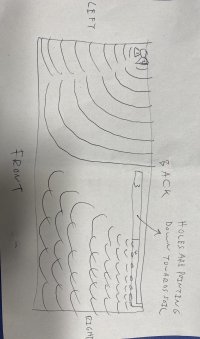I have been using EI dosing for 11 days now. I have followed all the instructions and made my macro and micro bottles and have been dosing according to the instructions.
I seem to be having a progressively worsening of this blue-green (my guess could be wrong) algae which is worst on my mosses but is also present on my aquarium glass. I've not had this type of algae before and it's starting to look unsightly as it's getting worse.
I have attached some pictures most of them are a week apart. The worst one if today and the others a week or 2 before.
The only other parameter I have changed apart from moving to EI dosing is that I increased my lighting duration from 6 hours to 6h 30 mins a day and that was 3 or 4 weeks ago now. When I did increase the lighting duration then I did notice some green film type algae on my crypts and red plants but these are going away now and have cleared off about 60% what they were before. The tank had such lush growth a few weeks ago it looks so different so fast.
I was just wondering what tweaking I should do next? I'm guessing there's more than enough nutrients if i'm using EI dosing and my CO2 checker is lime green throughout the photoperiod. Also not overfeeding the fishes. Just wondering if that only leaves tweaking with the light but i'm not sure.
Hello,
A rule of thumb is that if you are dosing EI level of nutrients and the tank experiences nutrient related algae then one must immediately suspect that flow/distribution is faulty.
It was difficult to see exactly how your distribution is configured, but it appears you have a small spraybar mounted at the upper left on the back wall and it also seems you have another filter outlet mounted on the left wall.
If the spraybars flow is pointed towards the front and if the side wall mounted outlet is pointed towards the right pane then this is a classic case of interfering flows. Both flow outputs essentially interfere and result in incoherence. This reduces the effectiveness of both flows and results in poor nutrient and CO2 distribution.
The most effective configuration is to place all filter outlet on the same wall, and of course the most effective wall will be the rear wall so that the distance the flow has to move is along the shortest distance. Sendin flow to the long distance of the tank is less effective, especially if it is being interfered with by flow from the perpendicular direction.
The best plan is to perform massive water changes frequently. Remove all affective leaves as they only spawn more algal spores.
Next, experiment with various combinations of the filter outlet mounting, ensuring that all outlets are mounted on the same wall pointing in the same direction. Water is heavy, weighing 8 lbs. per gallon. It s therefore very difficult to manipulate and so it requires as much energy you can muster to move it along. Use the energy of your pumps so that they work together, not at opposing angles.
Everybody thinks their flow/distribution and flow are OK, but everybody is wrong...
far as the OP question goes, you might want to cut the dosing in half and start from there, with that plant mass you might not need to dose the full EI doses.
Algae really do not care about the level of EI nutrients in the tank. PO4, NO3 and K are not the cause of algae.
Ammonia/Ammonium however is a completely different story. They can trigger algal blooms if used incompetently. The rate of NH3/NH4 concentration rise is one of the triggers. This, combined with possible oxygen depletion due to bacterial action can result in algal blooms - however, just because someone uses NH4/Urea and gets algae, this does not automatically mean that the algae is responding to the NH4/Urea. You have to determine what algal species is blooming. if the bloom being experienced is a CO2 related algae then that will have little to do with their NH4/Urea dosing. There are many ways to make mistakes and the OPs case is an example of that.
There is no need to reduce the nutrient loading. EI has NEVER advocated the use of NH4/Urea specifically because NH4/NH3 is a known algal trigger. When WE say nutrients don't cause algae NH3/NH4/Urea are excluded from our list of nutrients.
Having said that, NH4/Urea is a very effective means of Nitrogen uptake, and if used responsibly one can have success. Amano's ADA Aquasoil is very effective precisely because it soaks the clay particles with Ammonium Nitrate, however many experience algae at the sediment, so this is a risk. When new, Aquasoil leeches NH4 into the water column due to it's high concentration, so frequent water changes are advisable when using these types of enriched sediments in order to control the NH4 loading rate.
Cheers,



